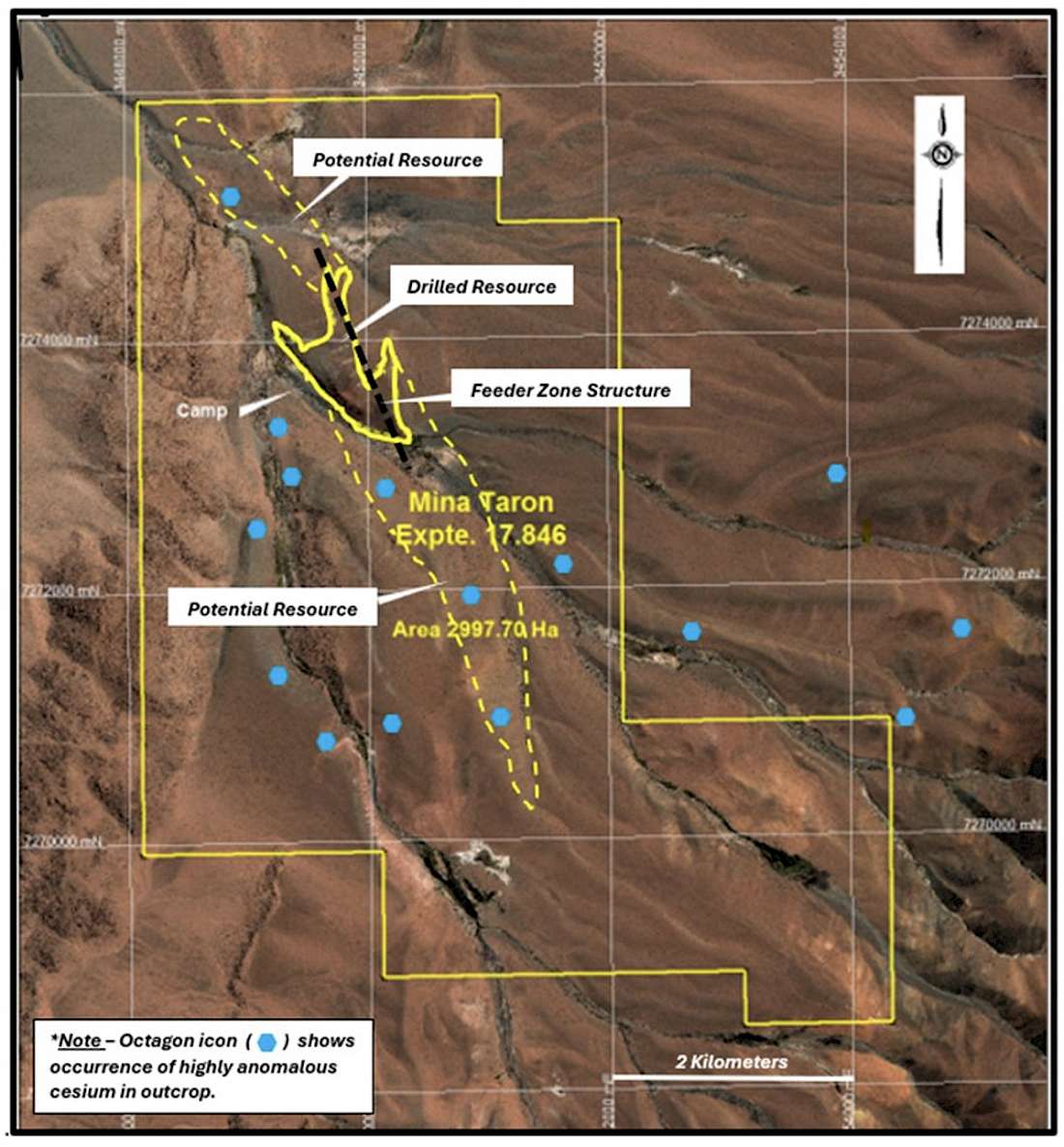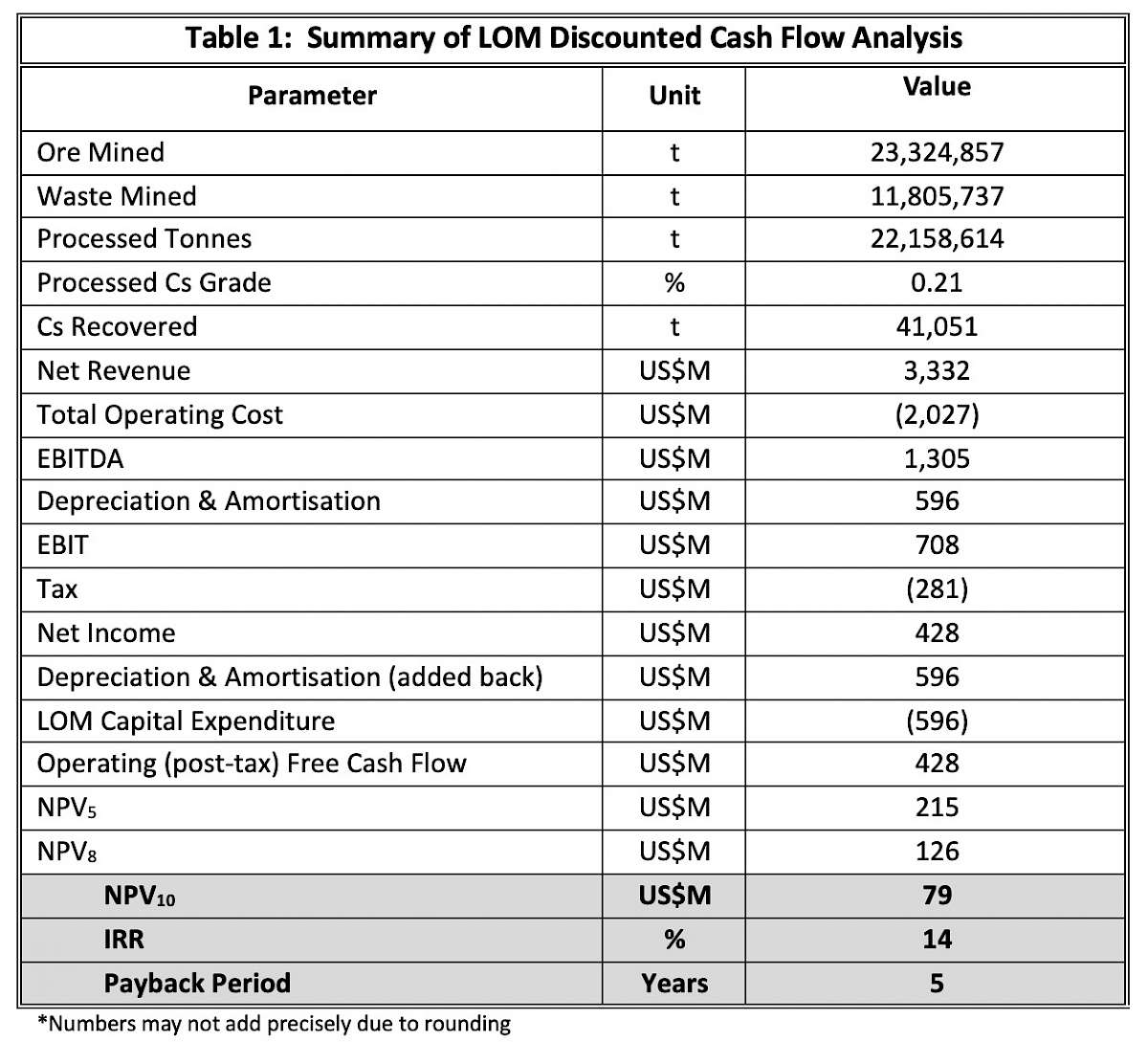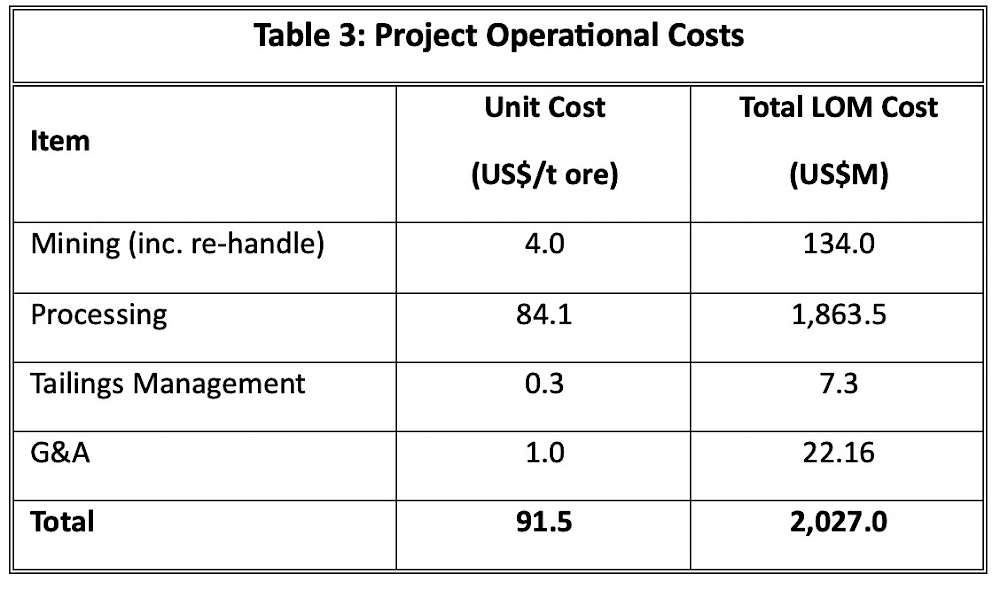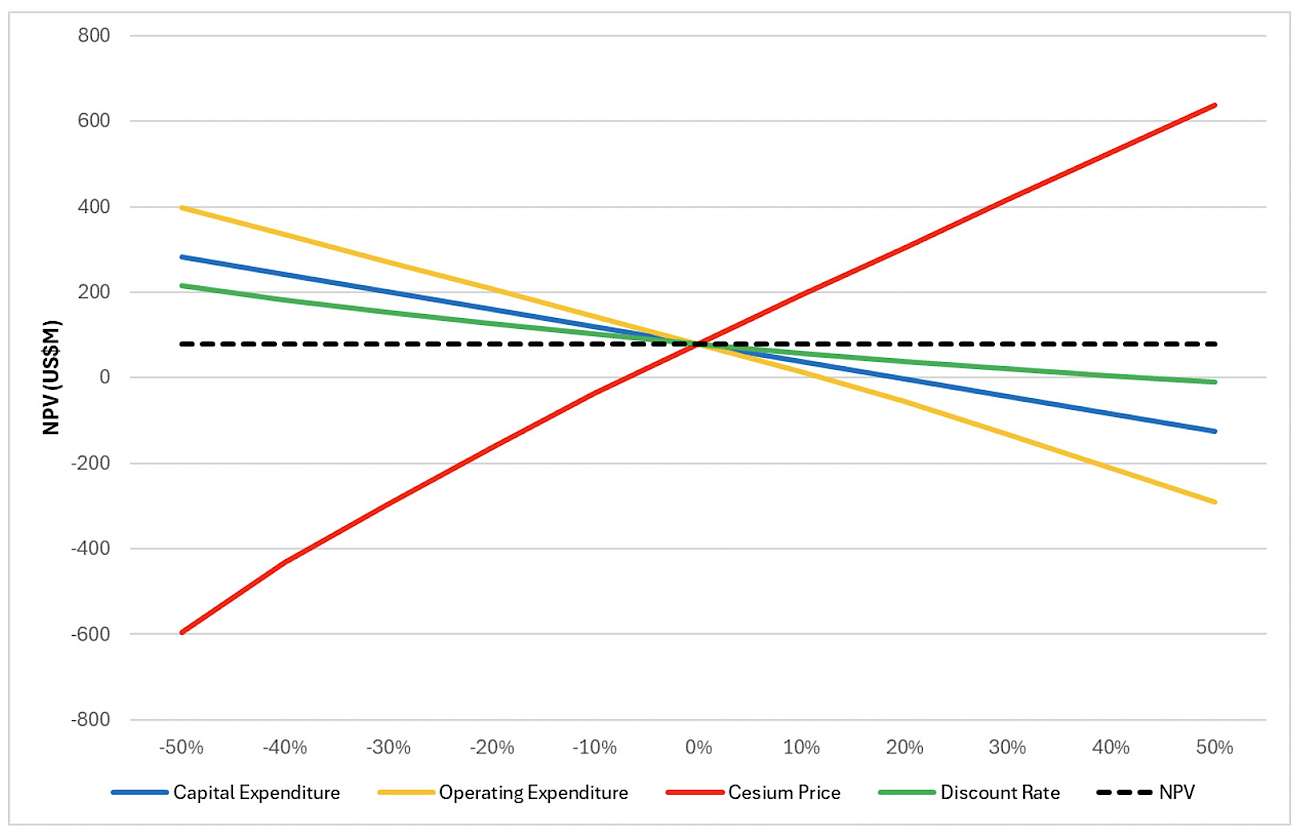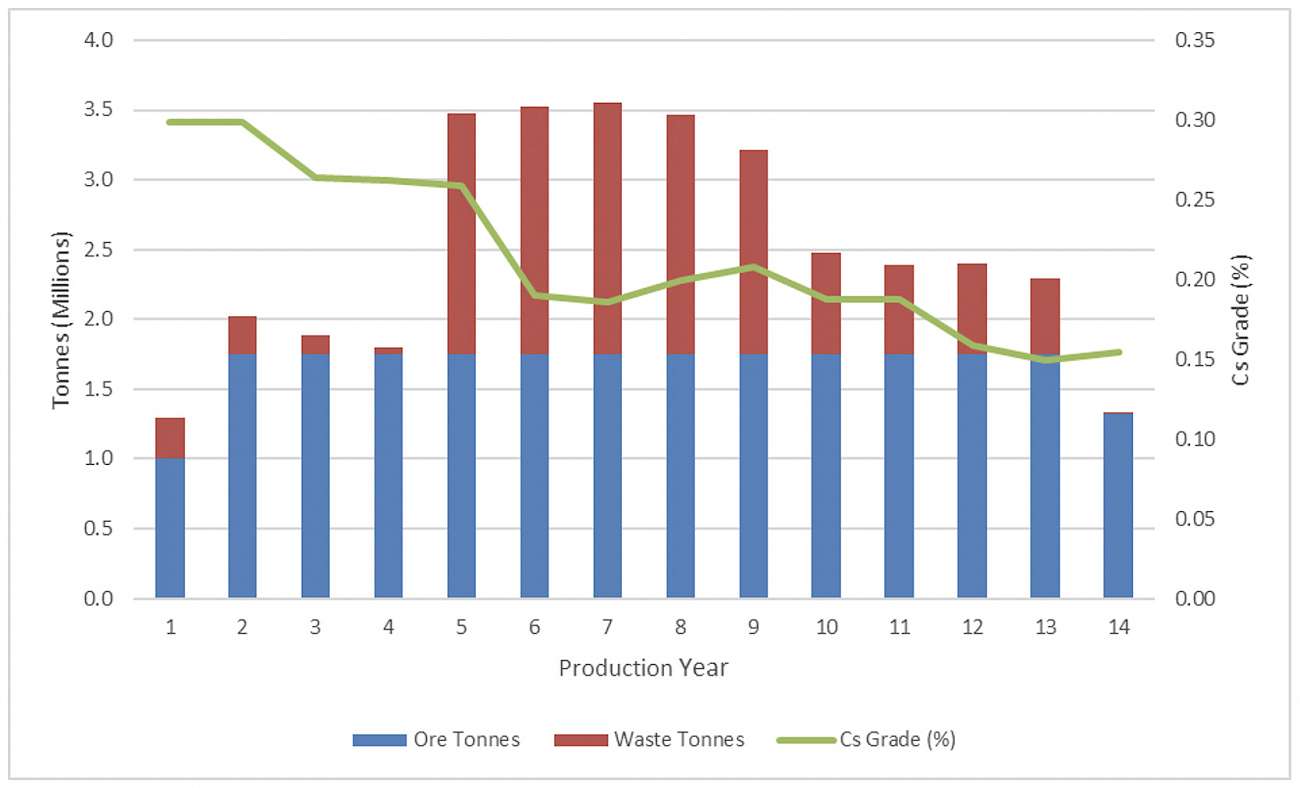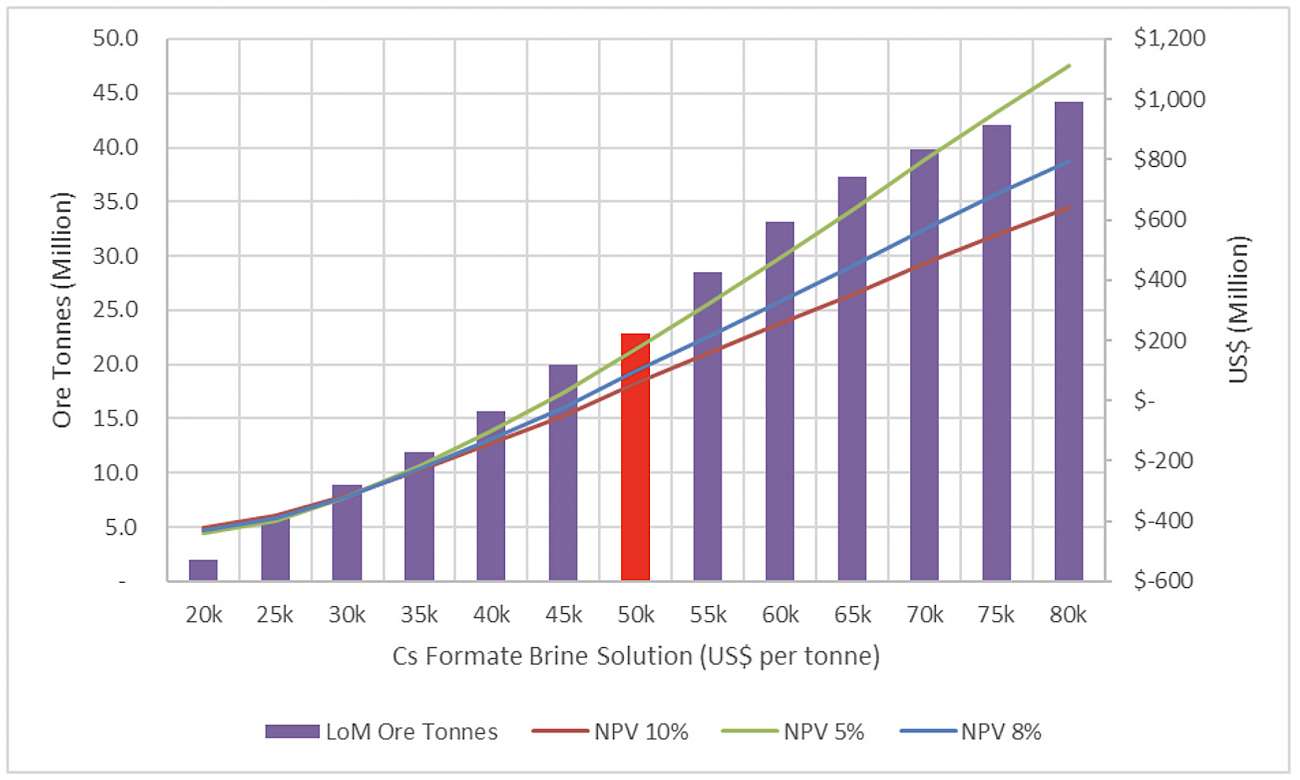- Resource of 50,810 tonnes of contained Cesium
- 23.85 Mt resource at a grade of 2,131ppm Cesium with significant potential to grow
- 14+ year mine life
- Strong NPV based on conservative pricing of Cesium Formate - 20% increase in prices can produce almost four times the NPV
- NPV (10) (after-tax) of US$79M, with an IRR of 14% (after tax) and payback period less than five years of operations
- Taron has the potential to be the world’s foremost supplier of Cesium
Vancouver, BC, Canada, May 15, 2024 – Cascadero Copper Corporation (“Cascadero” or the “Company”) (TSXV:CCD) is pleased to announce the successful completion of its Preliminary Economic Assessment (“PEA”) on its Taron Cesium Project (“Taron” or the “Project”) located in Salta, Argentina. The PEA indicates that the drilled portion of the Taron property has a 23.85 Mt at a grade of 2,131 ppm Cesium. Using the Company’s patented extraction process developed at the University of British Columbia and a Cesium Formate price of $50,000/t, the project has a 14+ years of mine life with a NPV(10) of US$79M, an IRR of 14% and a payback period of less than five years. The PEA was completed by Wardell Armstrong International (“WAI”).
In recognition of the opaque nature of the Cesium market, WAI conducted a resource sensitivity assessment at varying Cesium prices. An increase in Cesium Formate price of only 20% increases the NPV by almost four times (4X).
The PEA assessed the development of the Taron Project mineral resource by open pit mining, using the Company’s patented High-Pressure Acid Leaching (HPAL) process to produce a final solution containing Cesium hydroxide to which formic acid is added for the production of an 80% Cesium Formate brine.
Cascadero’s Interim Chief Executive Officer and Interim President, Dr. George Gale, stated: “This Preliminary Economic Assessment supports our assertion that the Taron Cesium Project has the potential to be the next primary Cesium producing mine in the world. The results of the Base Case study show positive economics, a long mine life and modest upfront capital cost, all in a favourable mining and permitting jurisdiction.”
Gale continued: “The Taron Project contains a globally significant mineable resource that has the potential to be greatly expanded by further exploration because only the portions of mineralisation that crop out have be drilled to date. The deposit is a thick accumulation of poorly consolidated gravels and sands that were mineralized by late hot spring fluids, which flowed through the sediments and precipitated a cement of Cesium-bearing minerals on the rock particles. The potential to expand the resource outside the current resource area is very likely as Cesium-bearing material has been found some five km from the current resource. With Cesium on the critical minerals lists of the International Energy Agency as well as United States, Canada, South Korea and Japan, and the lack of any meaningful supply, worldwide, Cascadero’s Taron Project has the potential to be the world’s next globally valuable and viable mining operation.”
Report will be filed on SEDAR within 45 days of this announcement.
Wardell Armstrong International (WAI) was retained by Cascadero to complete the PEA for the Taron Cesium Project located in the province of Salta, Argentina, and to prepare an independent Technical Report in accordance with the requirements of Canadian National Instrument 43-101 (NI 43-101) “Standards of Disclosure for Mineral Projects” of the Canadian Securities Administrators. The prime purpose of the PEA is to evaluate the economic viability of the Project and to establish an economic concept to justify further expenditure on this Project. In addition, the report supports public disclosure of a PEA that is based on the Mineral Resource Estimate (MRE) dated 31 January 2024, as prepared by WAI. The NI 43-101 PEA Technical Report will be filed on SEDAR within 45 days of this announcement.
Cesium Market Summary
Cesium is primarily used in Formate brines to assist in the drilling of high temperature and pressure oil and gas production wells. Other applications include the production of Cesium compounds such as Cesium bromide for use in infrared detectors, optics, photoelectric cells, scintillation counters and spectrometers.
The Tanco Mine in Manitoba, Canada is the world’s only currently viable Cesium mine, retaining approximately 116,400 tonnes of primary Cesium resources. In 2013 however, instability of the mine’s crown pillar forced its closure and it is unclear if mining operations have since been able to restart. In 2019, Tanco was purchased by Sinomine, a Chinese company that now claims to be the world’s only manufacturer and supplier of Cesium Formate with a market share nearing 100%. Sinomine also owns the world’s only other Cesium mine, namely the Bikita Mine in Zimbabwe, however its Cesium resources are thought to now be depleted. Sinomine also underwrote the Cesium supply output from the Sinclair Mine in Australia, however Sinclair completed its mining and transportation of all economically viable ore in early 2019.
As of the end of 2021, Sinomine global reserve of Cesium Formate was stated as 25,764bbl (≈10,000 tonnes), containing ~5,849 tonnes of Cesium metal equivalent. Based on modest assumptions for the Cesium price, the PEA indicates, the current resource at Taron is in the region of 40,000 tonnes of Cesium Formate brine (at 80% concentration) with 27,000 tonnes of contained metal.
As there are no confirmed active mining operations that can serve as a primary source for Cesium metal products, there is a high potential for mid- to long-term supply issues to exist, particularly when considering anticipated future market demand increases.
Preliminary Economic Assessment Summary
WAI recommends Cesium Formate brine be the assumed saleable product for the Taron PEA for the following reasons:
- Cesium Formate is the largest and most sustainable market for Cesium products;
- No confirmed active mining operations potentially creating long-term supply issues; and
- Tangible reasoning for anticipating an increase in product demand.
The Taron Property consists of five (5) Contiguous Mineral Tenures, approximating 8,179 hectares (83 Units) in area. The Tenures are registered to Cascadero Minerals S.A., which is 100% owned by Cascadero Minerals Corporation, a Canadian Company, which is 70% owned by Cascadero Copper Corporation and 30 % owned by Regberg Ltd (RB). CMC operates as a 70% CCD and 30% RB joint venture.
A summary of the life of mine discounted cash flow analysis is presented in Table 1. Utilizing a Cesium Formate price of US$50,000/t and a 10% discount rate, the NPV is US$79M, with an IRR of 14%. The Project payback period is estimated to be less than five years of operations.
Capital and Operating Costs
The capital and operating cost estimate summaries for the Taron Project are presented in Table 2 and 3, respectively. By using a contract miner, mining capital costs are minimised, but at the expense of higher mining operating costs.
Closure costs were incorporated into the operating costs for pit optimisation purposes (at US$1.0 per processed ore tonne) for the appropriate consideration of mine closure obligations, however the overall closure cost has been allocated as a capital cost for the Project financial evaluation and is accrued at the end of the mine life. No allowance for salvage has been included in the closure cost assumptions.
Note: Mining unit costs are based on per tonne ore mined, whereas all other costs consider per tonne ore processed (i.e less mining losses)
Average LOM Operating Cost = Total LOM Operating Costs/Total LOM Ore Tonnes Processed
Economic Analysis
The economic analysis uses a Discounted Cash Flow (DCF) approach, based on a post-tax, unleveraged, real-terms basis, to determine the Net Present Value (NPV), payback period (time in years to recapture the initial capital investment), and the internal rate of return (IRR) for the Project. Annual cash flow projections were estimated over the life of the mine based on the estimates of capital expenditures, production cost, and sales revenue. The analysis has been conducted in real terms with no consideration given to inflation or escalation of costs or prices over the life of the Project.
The long-term Cesium Formate brine price used in the economic analysis has been evaluated by WAI, based preliminary market analysis suitable for a PEA level of study, and agreed with the Company at US$50,000/t (no escalation), in real terms, over the life of the mine. A payability rate of 97% has been applied, to reflect 3% royalty payments. No price inflation or escalation factors were taken into account.
The economic analysis is prepared on a 100% equity project basis and does not consider financing scenarios. A 10% real discount rate has been used in the analysis. The economic model is based on the following assumptions and exemptions:
- Average throughput rate of 1.75Mtpa open pit operation extracting mineralised material from which Cesium Formate brines can be produced;
- Cesium Formate brine price is based on consensus equity research long-term commodity price projections and cost estimates in United States dollars (US$);
- Capital costs (CAPEX) and Operating costs (OPEX) have been estimated at a Preliminary Economic Assessment level of confidence (±40%);
- The contingency costs have been excluded from the CAPEX schedule; and
- All cost estimates have been calculated in 2024 money terms and, as such, the life of mine operating cost forecasts do not account for inflation.
The total capital cost estimate for the Taron Project is estimated at US$596.3M, of which the process plant equates to US$427.5M. The initial capital cost is US$477.7M with the remaining allocated to sustaining capital (US$96.4M) and closure costs ($US22.2M). By using a contract miner, mining capital costs are minimised – at the expense of higher mining operating costs.
The Project operating cost includes US$4.0/t for mining, US$84.1/t processing, US$0.3/t tailings management, and US$1.0/t for G&A. This equates to a total LOM operating cost of US$2,027.0M, or an average LOM operating cost of US$91.5/t ore processed.
The resultant DCF analysis, at a discount rate of 10%, has presented a positive NPV of US$79M, with an IRR of 14%. The Project payback period is estimated to be in the fifth year of operations.
Sensitivity analysis flexing the Project NPV shows that the Project is most sensitive to commodity price (and consequently grade). The Project NPV shows lesser sensitivity to operating expenditure, followed by capital expenditure and discount rate.
At a 10% discount rate, the NPV is US$79M, with an IRR of 14%. The Project payback period is estimated to be in the fifth year of operations. A summary of the key Project economics is presented in Table 4 below.
A sensitivity analysis respective to variations in the Cesium Formate brine price, operating costs, capital costs, and discount rate, was conducted to examine the sensitivity of the Model to changing economic conditions. As can be seen in Figure 1, the Project is most sensitive to Cesium pricing, less sensitive to operational and capital costing, and least sensitive to discount rate.
Figure 1: Taron Project Sensitivity Analysis
Mining
Mining will be from an open pit operation utilising traditional drilling, blasting, loading and hauling techniques, although it is currently thought that a proportion of the mined material will be free-digging. The PEA assumed employment of a mining contractor, which will reduce capital costs and accommodate fluctuations in annual material movement quantities. Ore material from the Taron pit will be hauled approximately 3km (ex-pit) directly to the run of mine (ROM) pad adjacent to the process plant. Waste rock will be hauled to a waste rock storage facility (WRSF) approximately 2km north of the pit exit. Mining rates peak at 1.75Mtpa and continue over a period of 14 years. As the deposit outcrops at surface, no pre-stripping phase is required with the first four years of mining producing minimal amounts of waste rock. Figure 2 below illustrates the Annual tonnes of Ore mined with average Cesium grade.
Figure 2: Annual Ore Tonnes Mined with Average Cesium Grade
Recovery Methods
To define the most economically viable recovery method for use in the PEA, trade-off studies were completed concerning the two processing routes under consideration for the Taron deposit, namely:
- Atmospheric Leaching; and
- High-Pressure Acid Leaching (HPAL).
Although the atmospheric leaching option demanded significantly less capital investment whilst offering improved process recoveries, high acid consumption rates resulted in unsustainable operational costs – thus significantly impacting the minable resource potential.
The comparatively lower acid and limestone consumption offered by HPAL more than compensates for the additional Project CAPEX demands and lower process recoveries. Consequently, and based on available test work data, the HPAL option was selected as the process method for the PEA works.
For initial design purposes, the ROM grade of 0.2144% Cs is assumed and processed at a rate of 1.75Mtpa for a LOM of 14 years. Assuming 350 operating days for a plant availability of 95.9%, a throughput of 5,000tpd (208tph) is required. A conceptual process flowsheet considering the HPAL method is described as follows.
- ROM ore will be delivered to a feed bin and conveyed to a rotary breaker. Coarse gangue material will be rejected as waste with undersize conveyed to a ball mill. The ball mill will operate in closed circuit with cyclone overflow from hydrocyclone classifiers feeding the autoclave circuit. Two autoclave circuits will operate in parallel to provide operational redundancy. After leaching, the resulting solution containing the dissolved Cesium and other impurity elements reports to the downstream Cesium extraction plant. Aluminium sulphate is added to the leach solution followed by cooling to promote rapid formation of the impure Cesium alum crystals. After recovery by filtration, the crystals are re-dissolved and subsequently cooled once again to form pure Cesium alum crystals, before a final stage of dissolution for treatment with barium hydroxide in two stages.
- The first stage removes aluminium as aluminium hydroxide and some barium sulphate. The second stage then removes the balance of the sulphate as barium sulphate.
- The final solution contains Cesium hydroxide to which formic acid is added for the production of an 80% Cesium Formate brine for direct sale to market.
Market Studies and Sensitivity Analysis
Cesium is primarily used in Formate brines to assist in the drilling of high temperature and pressure oil and gas production wells. As such, WAI have conducted the study on the assumption that Cesium Formate brine will be the primary saleable product for the Taron Project.
Based on a PEA level market assessment and using the information available, WAI derived a long-term Cesium Formate brine cost of US$50,000 per tonne (at 80% concentration). However, due to Cesium not being readily traded in commercial quantities and the market for Cesium products being notoriously opaque in nature, little publicly available data on supply/demand and pricing is available to reliably verify the price assumptions used. This being said, WAI regard the price derivation to be a suitable estimation at this stage of Project development.
In recognition of the of the opaque nature of the Cesium market, WAI conducted a resource sensitivity assessment at varying Cesium prices. The results are summarised by the graph below, with the US$50,000 per tonne PEA scenario highlighted in red. It can be seen in Figure 3 that there is a distinct sensitivity on Cesium Formate pricing an increase of 20% in Cesium pricing will improve NPV four fold.
Figure 3: Resource Size and NPV Sensitivity for Varying Cesium Formate Pricing
Environmental and Social
The necessary and preliminary environmental and social baseline study has been completed and submitted to the Commercial Mines Court of Registry of the Ministry of Mining. The environmental permit allowing surface exploration in the Project area requires the Biannual Renewal of the Environmental Impact Report (BREIR). The Project is currently licensed under the December 2022 decision, however the baseline data for the 2022 BREIR is now considered to be outdated and therefore requires addressing.
The Project is in an area of very low population density with no permanent dwellings or farmsteads located on the concession area, the nearest settlement being 30km to the northwest at Santa Rosa de los Pastos Grandes (population of 150). Grazing animals (sheep and llama) do occasionally pass through the licence area, possibly taking advantage of the small streams flowing broadly southeast – northwest.
Additional baseline studies will need to take place in order to collect information on the complete environmental and social setting of the Project. Particular attention should be given to a consistent flora and fauna baseline, along with hydrology and soil characterisation. This will allow modification of Project components and potential avoidance of significant impacts.
Notwithstanding any shortcomings highlighted, and the requirement to instigate baseline and other studies, at this stage of work the Project does not appear to present any significant challenges to development and securing the necessary permits to do so.
Mineral Resource Estimate
Geological modelling, block modelling, and grade estimation for the Taron deposit has been carried out by GeoSim Services Inc. The work completed by GeoSim was done in preparation for the 2017 NI 43-101 Technical Report for the Taron deposit however this was considered a Mineral Inventory as reasonable prospects of eventual economic extraction (RPEEE) could not be declared at the time. WAI has reviewed all work completed by GeoSim and prepared the block model for optimisation and the application of current RPEEE factors for reporting Mineral Resources in accordance with the guidelines of the JORC Code (2012).
The resultant estimated grades were validated against the input composite data. Resource classification was undertaken in accordance with the guidelines of the JORC Code (2012) and was based on an assessment of geological and grade continuity, an assessment of assay quality, and an assessment of available bulk density data. Mineral Resources were further limited based on an expectation of eventual economic extraction to an optimised open pit shell generated using appropriate economic and technical parameters. Mineral Resources were reported to an economic cut-off grade of 1,239ppm Cs as calculated from optimisation parameters and summarised in Table 5 below.
Technical information in this press release has been reviewed and approved by Dr. George H Gale, PEng and Tony Cau, BSc Eng for Cascadero, both of whom are considered to be qualified persons under Canadian National Instrument 43-101.
Notes on Mineral Resources Estimate
- Mineral Resources are not Mineral Reserves and have not demonstrated economic viability. Additional drilling will be required to convert Inferred Mineral Resources to indicated Mineral Resources or Mineral Reserves. There is no certainty that any part of a Mineral Resource will ever be converted into Mineral Reserves
- The effective date of the Mineral Resource Estimateis 31 January 2024.
- All figures are rounded to reflect the relative accuracy of the estimate, and apparent errors may occur due to rounding.
- Mineral Resources reported from optimisation at SMU 10m x 10m x 10m.
- Mineral Resources are limited to an optimised open pit shell based on appropriate economic and mining parameters.
- Cesium prices during optimisation were US$50,000/t for a Cesium Formate brine product at 80% concentration.
- Mineral Resources have been classified in accordance with the guidelines of the JORC Code (2012) by Ché Osmond, an independent Competent Person as defined by JORC.
- The Mineral Resource estimate has not been affected by any known environmental, permitting, legal, title, taxation, socio-political, marketing or any other relevant issues.
- Mineral Resources are reported to a cut-off grade of 1,239 ppm Cs for potential open pit mining operations. Cut-off grades are economic cut-off grades based in optimisation parameters provided by Cascadero and assumptions made by WAI.
Technical information in this press release has been reviewed and approved by Dr. George H Gale, PEng and Tony Cau, BSc Eng for Cascadero, both of whom are considered to be qualified persons under Canadian National Instrument 43-101.
About Cascadero Copper Corporation
Cascadero Copper Corporation is focused on the exploration and development of its copper, gold and Cesium properties located in Salta, Argentina. In addition to the Taron Cesium Project, the Company has a joint venture with Golden Minerals on its Sarita Este license where Golden Minerals has drilled out a small gold discovery. Cascadero also has significant landholdings adjacent to First Quantum Minerals’ Taca Taca copper-gold-molybdenum porphyry deposit. The Company also holds a number of other exploration properties that can be viewed on www.cascadero.com.
All material information on the Company may be found on its website at www.cascadero.com and on SEDAR at www.sedar.com.
For further information, please contact:
Dr. George Gale
Interim CEO
Email: georgegalevp@yahoo.ca or info@cascadero.com
Cautionary Note: The preliminary economic assessment is preliminary in nature and includes inferred mineral resources that are considered too speculative geologically to have the economic considerations applied to them to enable them to be categorized as mineral reserves and there is no certainty that the preliminary economic assessment will be realized. Mineral resources that are not mineral reserves do not have a demonstrated economic viability.
This press release contains certain forward-looking information or forward-looking statements as defined in applicable securities laws. Forward-looking statements are not historical facts and are subject to several risks and uncertainties beyond the Company’s control, including statements regarding the economic and operational potential of the Taron Cesium Project, potential acquisitions, plans to complete exploration programs, potential mineralization, exploration results and statements regarding beliefs, plans, expectations, or intentions of the Company. Resource exploration and development is highly speculative, characterized by several significant risks, which even a combination of careful evaluation, experience and knowledge may not eliminate. All forward-looking statements herein are qualified by this cautionary statement. Accordingly, readers should not place undue reliance on forward-looking statements. The Company undertakes no obligation to update publicly or otherwise revise any forward-looking statements whether as a result of new information or future events or otherwise, except as may be required by law.
Neither the TSX Venture Exchange nor its Regulation Services Provider (as that term is defined in the policies of the TSX Venture Exchange) accept responsibility for the adequacy or accuracy of this press release.
